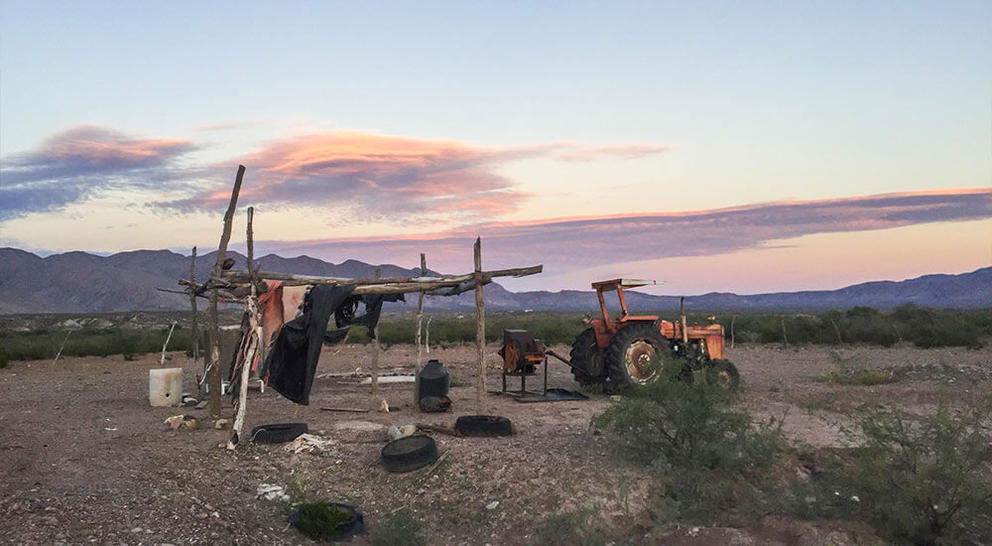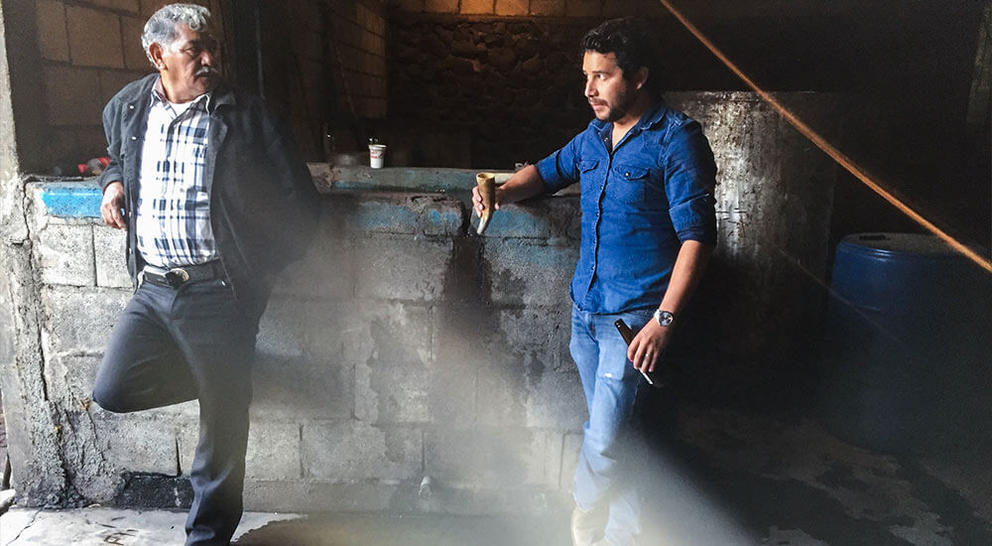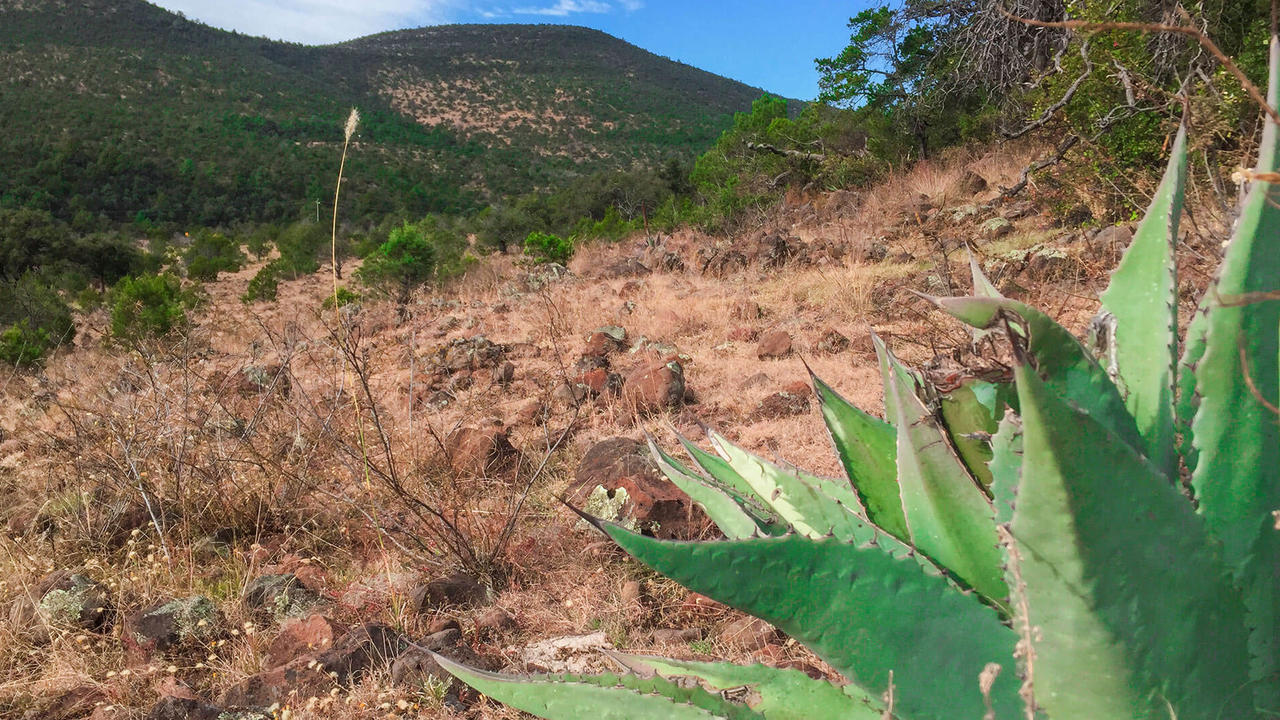To straighten out all things Sotol, I invited my friend Ricardo Pico from Chihuahua, the home state of Sotol, to a talk. Ricardo has been instrumental in spreading the gospel and knowledge of Sotol to the world. He’s behind several crafted brands and most recently a key player for the world’s first global Sotol brand partly funded by a spirit giant and backed by a celebrity, rock star Lenny Kravitz.
Ricardo has been working in the sotol industry for more than a decade and started out as a brand rep for one of the first sotol brands gone global, later starting some brands of his own.
Today, he is a partner and the Global Educator of a project called Noche Luna, launched in October 2022. On the side, he has his own project and brand called Sotoleros where he works closely with 12 small artisanal producers in Chihuahua. Besides Sotol, they also produce and bottle Ensambles (a mix of Sotol and Agave) and Lechuguilla (a local agave spirit).
Unlocking the tastes of the earth
In the context of Sotol, the state of Chihuahua is divided into two subregions: the eastern part is desert, and the western part is forest. The plants stay in the same ground under the same sun for 12, 15, or even 18 years, collecting all data from their surroundings: which other plants grow in the area? What kind of soil do they grow in? How has the weather changed over time?
All this data gives different layers of flavours. As the plants are cooked, fermented, and distilled, all this data is decoded and reflected in the taste of the spirit.
For example, from the desert, we get a very decadent Sotol with salty minerals, mint, and cacao. Sotol from the forest region gives umami notes like mushrooms and moss, but also fresh and crisp notes of eucalyptus and pine.
And it’s not only sotol plants that grow wild in this area, but agave. Sometimes, maestros collect wild agaves and sotol plants, and cook, mill, ferment, and distill them together. Those blends are what we call Ensembles.
If you only use agaves, the spirit is called Lechuguilla. Lechuguilla is mainly produced in the southwestern part of Chihuahua and it’s a spirit shared with the state of Sonora, but it doesn’t have a Protected Designation of Origin (PDO).
When the norm covering Sotol was established in 2004, two years after the official PDO was granted, it pretty much was a carbon copy of Tequila, leaving the minimum content of sugars from the sotol plant to 51% to be called Sotol.
Sotol distillery in Mexico
The magic potion of ancestors
Diving into the history of Sotol, we find agave and sotol plants more than 10 000 years ago, among native people of both Mexico and the southern U.S. These people were collectors and foragers who put plants to different uses, learning along the way that cooking the plants released a lot of nutrients.
The legend tells a story of a lazy man who cooked sotol plant for his meal, leaving the cooked plants lying around which over time began to ferment. A bear came and ate some of the fermented plants, becoming intoxicated. The people of the village saw this, learning that by eating, and later drinking fermented sotol, one can reach “a magical state”.
In the 1500s, Spaniards came and introduced the distillation methods.
The craft that survived the prosecution
With the introduction of distillation, the production of Sotol became accessible to all, and it became the drink of peasants, farmers, and poor people. During the 1800s, Mexico took a spin toward European trends. A preference for Scotch, Cognac, and brandies emerged among the wealthy and powerful, leaving authentic Mexican spirits like Mezcal and Sotol as something to be frowned upon.
In the early 1900s, the bordering state of Sonora put a ban on the local spirit Bacanora (also an agave spirit with a PDO), setting the example for Chihuahua to follow. Many maestro sotoleros were prosecuted and punished, having their equipment destroyed by the police and military. This forced them to always be on the move, carrying around their copper stills. The stills were very heavy and hard to transport, but it was their most valuable resource: one could always dig another oven or fermentation vat. If taken or destroyed, the copper still would be irreplaceable.
The prohibition in the U.S. also added a layer to this challenge, as a lot of contraband alcohol got smuggled across the border. The U.S. government pressured Mexico to stamp out Sotol, Bacanora, and Lechuguilla producers. Don Lalo Arrieta, the maestro behind Ricardo’s Sotoleros project Noche Luna, shared that, in those days, “when one would see the dust rising from the distance, it was a sign that enforcers were on their way and it was time to pack up and leave”.
This is why today, Sotol really represents the liquid art form that survived the prosecutions and bad reputation. It has been rescued, finally valued and respected. Don Lalo, Don Bienvenido Fernandez (also part of Sotoleros) and other small producers that kept the craft and the recipe alive, are the real protectors of this art form, category, and designation of origin.
“I think it’s very valuable and it means a lot that we can still enjoy the spirits and knowledge ofthese maestros,” Ricardo said in our conversation about Sotol. “It is a beautiful industry also in the sense that, just by making and consuming these spirits, we’re supporting the industry that can change so many lives: of maestros, of their kids and grandkids, and of the community itself. That’s the beauty of this all,” Ricardo shares.
Taking Sotol to the world
When it comes to the future and question as to whether Sotol will see the same success as Tequila and Mezcal - Ricardo is very hopeful.
“I think we’ve been down a path where Tequila, and now also Mezcal, have opened the door for new categories. I think that eventually we will have a bigger market participation and growth, and I believe that the rhythm will be the same as what happened with Mezcal,” Ricardo said.
“Today, Sotol is where Mezcal was 15 years ago. That gives us enough time to learn from good and bad experiences. As you grow, new challenges are coming. Like today, we rely on wild plants. But even though we have a lot of land, we must have a plan. We must be efficient and we must grow more plants and set an agricultural model,” Ricardo continues.
“I foresee that in 10 years from now, when you drive from Chihuahua City to the vinatas in Aldama or Coyama, or to the vinatas in the desert, along the roads, you’ll see huge healthy sotol plants. Then, we’ll have a plant market which is very healthy and we won’t rely on wild plants anymore,” Ricardo shares about his vision for Sotol.
Today, the governmental institution makes an environmental assessment and a total count of mature plants. From this, they calculate a percentage of how many plants can be harvested each year. Ricardo, his team, and other similar projects, are creating cultivation fields by sprouting plants from the collected seeds. These plants are grown for a couple of years to develop their teeth so they can defend themselves in the wild, and then they’re put in the wild cultivation fields. The Sotoleros are working with the University of Chihuahua and other researchers and academics, exploring the best practices for growing the sotol plants in cultivation. According to Ricardo, their findings so far are positive and optimistic.
“Instead of growing plants for 12-15 years in the wild, without sources of water, we can grow them in 8-10 years, and still get bigger plants with higher sugar concentration. This brings us into a very interesting and fruitful scenery for the future. In order for us to be successful sotol brand owners, I think we primarily need to be successful sotol farmers, and that’s where we are right now,” Ricardo says.
Mexican spirits move hearts and household economics in the country
Lastly, in the tequila industry and to some extent in the mezcal industry, the celebrity brands have become a bit like a hot potato, especially among people like myself in the outer circles of the industry - brand workers and aficionados. So I asked Ricardo what his take is on celebrity brands at large within the Mexican spirits community and category, considering that for example, a celebrity rockstar Lenny Kravitz is part of the Noche Luna project.
“Firstly, we can’t put all the brands and projects under one light, there are so many shades. One thing that is important, regardless of who is involved and how, is awareness. In general, Mexican spirits as a category need more information, more knowledge, more ambassadors for awareness, and I think celebrities can contribute to this greatly. It’s also a matter of the purist perspective when we talk about this. Sometimes, brands make huge volumes, which may not be done in a sustainable or respectful manner. But sometimes, they also make products that are good, well-made, and create job opportunities in our country - which is greatly needed,” Ricardo shares. “They bring food to the tables of many homes, to families of farmers, jimadores, and entire chains of people behind the production. There is a duality that is very interesting because for us to have the 50+% ABV small batch Sotols, we must have the commercial 40-45% ABVs or the bigger brands. This is something that will build the category and build awareness and shed light on the small projects. Then we have the celebrities who are the spokespersons for the projects that I am very proud of,” says Ricardo.
At the end, he added that this effort doesn’t fall under the typical empty or soulless business or idea, explaining that “this is a project that comes from the heart of the people who have been working with us for five years now. They started with us and trusted in what we do. Now we finally see it come into fruition.” 
Sotoleros: Don Bienvenido Fernandez and Ricardo Pico
Ricardo also shared more about Don Lalo, who is a full partner on the project. Don Lalo is a 69-year-old man and 4th generation maestro, born and raised in the desert. He was taught by his father Daniel and his grandfather Eduardo, and he learned the traditional way and the way of parejo. Projects like Ricardo’s shine light on people like Don Lalo and treasure his heritage, crediting him as the great maestro and the spirit maker that he is - worldwide.
As a conclusion
I expressed my gratitude to Ricardo for taking his time to give us perspective on Sotol. To share in Ricardo’s own sweet and very true words:
“Support Mexican spirits, producers, and the fields. Whenever you drink Mexican spirits, you help the country, you help people and you taste the heart, the passion, and centuries of work by those working the fields - and everyone involved is grateful for this.
Know that you are always welcome in Mexico. We love having people down here and more than making clients and business, we make friends. It’s beautiful to just share this love and hospitality. And a big thank you to European Bartender School! I’ll raise a toast to you guys tonight. ¡Un abrazo!”
In summary, Sotol may not be made from Agave, but the bond, heritage, culture and production goes hand in hand. If Mezcal is the mother and Tequila the daughter first risen to global stardom, Sotol is the close cousin growing up under the same roof.
All images used in the article are from Björn Kjellberg's private collection.
Björn Kjellberg, Norrviken, Stockholm, April 2023

